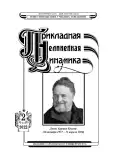Simple and complex dynamics in the model of evolution of two populations coupled by migration with non-overlapping generations
- Authors: Kulakov M.P.1, Frisman E.Y.1
-
Affiliations:
- Institute for Complex Analysis of Regional Problems of Russian Academy of Sciences, Far Eastern Branch
- Issue: Vol 30, No 2 (2022)
- Pages: 208-232
- Section: Articles
- URL: https://journals.rcsi.science/0869-6632/article/view/252093
- DOI: https://doi.org/10.18500/0869-6632-2022-30-2-208-232
- ID: 252093
Cite item
Full Text
Abstract
About the authors
Matvej Pavlovich Kulakov
Institute for Complex Analysis of Regional Problems of Russian Academy of Sciences, Far Eastern Branchul. Sholom-Aleikhema, 4, Birobidzhan, 679016, Russia
Efim Yakovlevich Frisman
Institute for Complex Analysis of Regional Problems of Russian Academy of Sciences, Far Eastern Branchul. Sholom-Aleikhema, 4, Birobidzhan, 679016, Russia
References
- Haldane J. B. S. A mathematical theory of natural and artificial selection. Part II. The influence of partial self-fertilisation, inbreeding, assortative mating, and selective fertilisation on the composition of Mendelian populations, and on natural selection // Biological Reviews. 1924. Vol. 1, no. 3. P. 158-163. doi: 10.1111/j.1469-185X.1924.tb00546.x.
- Fisher R. A. The Genetical Theory of Natural Selection. Oxford: Clarendon Press, 1930. 272 p. doi: 10.5962/bhl.title.27468.
- Wright S. Evolution in Mendelian populations // Genetics. 1931. Vol. 16, no. 2. P. 97-159. doi: 10.1093/genetics/16.2.97.
- Фрисман Е. Я., Шапиро А. П. Избранные математические модели дивергентной эволюции популяций. М.: Наука, 1977. 152 с.
- Свирежев Ю. М., Пасеков В. П. Основы математической генетики. М.: Наука, 1982. 512 с.
- Фрисман Е. Я., Первичная генетическая дивергенция (Теоретический анализ и моделирование). Владивосток: ДВНЦ АН СССР, 1986. 160 с.
- Burger R. A survey of migration-selection models in population genetics // Discrete & Continuous Dynamical Systems - B. 2014. Vol. 19, no. 4. P. 883-959. doi: 10.3934/dcdsb.2014.19.883.
- Carroll S. P., Hendry A. P., Reznick D. N., Fox C. W. Evolution on ecological time-scales // Functional Ecology. 2007. Vol. 21, no. 3. P. 387-393. doi: 10.1111/j.1365-2435.2007.01289.x.
- Pelletier F., Garant D., Hendry A. P. Eco-evolutionary dynamics // Phil. Trans. R. Soc. B. 2009. Vol. 364, no. 1523. P. 1483-1489. doi: 10.1098/rstb.2009.0027.
- Yeaman S., Otto S. P. Establishment and maintenance of adaptive genetic divergence under migration, selection, and drift // Evolution. 2011. Vol. 65, no. 7. P. 2123-2129. doi: 10.1111/j.1558-5646.2011.01277.x.
- Bertram J., Masel J. Different mechanisms drive the maintenance of polymorphism at locisubject to strong versus weak fluctuating selection // Evolution. 2019. Vol. 73, no. 5. P. 883-896. doi: 10.1111/evo.13719.
- Neverova G. P., Zhdanova O. L., Frisman E. Y. Effects of natural selection by fertility on the evolution of the dynamic modes of population number: bistability and multistability // Nonlinear Dyn. 2020. Vol. 101, no. 1. P. 687-709. doi: 10.1007/s11071-020-05745-w.
- Zhdanova O. L., Frisman E. Y. Genetic polymorphism under cyclical selection in long-lived species: The complex effect of age structure and maternal selection // Journal of Theoretical Biology. 2021. Vol. 512. P. 110564. doi: 10.1016/j.jtbi.2020.110564.
- Telschow A., Hammerstein P., Werren J. H. The effect of Wolbachia on genetic divergence between populations: Models with two-way migration // The American Naturalist. 2002. Vol. 160, no. S4. P. S54-S66. doi: 10.1086/342153.
- Fussmann G. F., Loreau M., Abrams P. A. Eco-evolutionary dynamics of communities and ecosystems // Functional Ecology. 2007. Vol. 21, no. 3. P. 465-477. doi: 10.1111/j.1365-2435.2007.01275.x.
- Tellier A., Brown J. K. M. Stability of genetic polymorphism in host-parasite interactions // Proc. R. Soc. B. 2007. Vol. 274, no. 1611. P. 809-817. doi: 10.1098/rspb.2006.0281.
- Nagylaki T., Lou Y. The dynamics of migration-selection models // In: Friedman A. (ed) Tutorials in Mathematical Biosciences IV. Vol. 1922 of Lecture Notes in Mathematics. Berlin, Heidelberg: Springer, 2008. P. 117-170. doi: 10.1007/978-3-540-74331-6_4.
- Akerman A., Burger R. The consequences of gene flow for local adaptation and differentiation: a two-locus two-deme model // J. Math. Biol. 2014. Vol. 68, no. 5. P. 1135-1198. doi: 10.1007/s00285-013-0660-z.
- Пасеков В. П. К анализу слабого двулокусного отбора по жизнеспособности и квазиравновесия по сцеплению // Доклады Академии наук. 2019. Т. 484, № 6. С. 781-785. doi: 10.31857/S0869-56524846781-785.
- Фрисман Е. Я., Кулаков М. П. О генетической дивергенции в системе двух смежных популяций, обитающих на однородном ареале // Известия вузов. ПНД. 2021. Т. 29, № 5. С. 706-726. doi: 10.18500/0869-6632-2021-29-5-706-726.
- Фрисман Е. Я., Жданова О. Л., Кулаков М. П., Неверова Г. П., Ревуцкая О. Л. Математическое моделирование популяционной динамики на основе рекуррентных уравнений: результаты и перспективы. Ч. II // Известия РАН. Серия биологическая. 2021. № 3. С. 227-240. doi: 10.31857/S000233292103005X.
- Altrock P. M., Traulsen A., Reeves R. G., Reed F. A. Using underdominance to bi-stably transform local populations // Journal of Theoretical Biology. 2010. Vol. 267, no. 1. P. 62-75. doi: 10.1016/j.jtbi.2010.08.004.
- Laruson A. J., Reed F. A. Stability of underdominant genetic polymorphisms in population networks // Journal of Theoretical Biology. 2016. Vol. 390. P. 156-163. doi: 10.1016/j.jtbi.2015.11.023.
- Гонченко А. С., Гонченко С. В., Казаков А. О., Козлов А. Д. Математическая теория динамического хаоса и её приложения: Обзор. Часть 1. Псевдогиперболические аттракторы // Известия вузов. ПНД. 2017. Т. 25, № 2. С. 4-36. doi: 10.18500/0869-6632-2017-25-2-4-36.
Supplementary files










